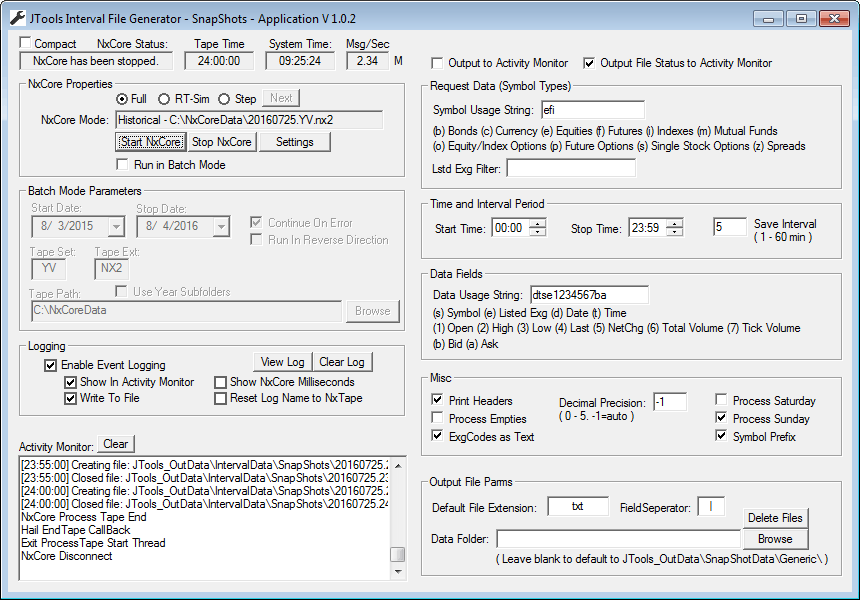JTOOLS INTERVAL FILE GENERATOR - SNAP SHOTS
JTools Table of Contents
Project Location: \JTools_IntervalFileGenerator_SnapShots
One of the most common custom application types we develop for customers are
Snap Shot reports. While they may be generated during the trading day, they
have a common theme of being comprised of composite data for multiple symbols
and almost always containing the daily Open-High-Low-Last-Volume, etc . Some of
these run one time, generally at the end of the trading Day, while many
generate regularly timed files throughout the day.
The JTools_SnapShotFileGenerator allows you to dump summary trade information
for the entire universe of symbols in almost any fashion you desire. The system
gathers information from NxCore State Trades. As such it can be run from state
files generated just before or at the desired time. Every field available for
NxCoreStateTrade is offered as possible output. Fields generated and field
order, as well as symbol types (IE Equities, Futures, Indexes, etc) are
determined by the usage strings (see below for a complete list of possible
fields).
The JTools Interval Generator for Snapshots also combines the functionality of
the JTools Batch
Processor to make processing data which spans days, months or years
trivial.

Snapshot interval data timestamps will mark the exact time of the interval
snapshot. For instance, if 5 minute interval data is chosen, an interval at
9:35 will represent the field values at exactly 9:35. Open-High-Low-Close and
Volume will all reflect the *daily* values for these fields, at the specific
time.
Request Data Parameters:
- Symbol Usage String - Possible values:
(b) Bonds (c) Currency (e) Equities (f) Futures (i) Indexes (m) Mutual Funds
(o) Equity/Index Options (p) Future Options (s) Single Stock Options (z)
Spreads
- Listed Exg Filter - "0"=Include all exchanges. If only
specific exchanges are desired, enter those exchange here, comma separated. IE
for NYSE and NQEX - 3,12
|
Time and Interval Period Parameters:
- Start Time (HHMM) - Time that the application will start
collecting/generating snapshot data. Example - "09:30".
- Stop Time (HHMM) - Time that the application will stop
collecting/generating snapshot data. Example - "16:00".
- Save Interval (1-60) - Amount of minutes between each snapshot.
|
Data Fields Parameters:
- Data Usage String - Possible values:
(s) Symbol (e) Listed Exg (d) Date (t) Time (1) Open (2) High (3) Low (4) Last
(5) NetChg (6) Total Volume (7) Tick Volume (p) Price (r) Price Type (b) Price
Flag (c) Condition Flag (f) Volume Type (h) Threshold (x) Tick (u) UserData (i)
Index
The field order of the output data will match the field order of the Data Usage
String supplied.
|
Misc Parameters:
- Print Headers - Print headers in output file if checked.
- Exg Codes as Text - If checked, exchange codes are output as text,
otherwise they are output as numeric.
- Process Empties - If checked issues with no data for the interval
will be included and zeroed. If unchecked, only intervals where trading data
was recorded will be output.
- Decimal precision - ("0" - "5", "-1"
for auto based on price type).
- Process Saturday - If checked files will be generated on Saturday.
- Process Sunday - If checked files will be generated on Sunday.
- Symbol Prefix - If checked symbol prefixes will be output with the
symbol.
|
Output File Parameters:
- Data Folder - Folder data files are created in.
If left blank, the output files will be generated in the sub-folder
JTools_OutData\IntervalData\SnapShots. The sub-folder will be located in the
same folder that the application runs from.
- Default File Extension - The default file extension to use for
filenames.
- Field Separator - A single character used to separate data fields
within the files.
|
Batch Mode Parameters:
- Run in Batch Mode - If checked, batch parameters become enabled and
allow the application to process files in a "Batch Mode". If
unchecked, individual files or realtime mode may be chosen in the standard
settings window.
- Start Date - Date of the first historical file to be processed.
- Stop Date - Date of the last historical file to be processed.
- Tape Set - The NxCore 2 or 3 letter tape set code.
- Tape Ext - The NxCore tape extension (nxc, nx2 or nx3).
- Tape Path - Path to the historical tapes.
- Use Year Subfolders - Many users will organize their historical
tapes by year (such as Data\2016, Data\2015, etc). If 'Use Year Subfolders' is
enabled then the application will search in the Tape Path folder + the year
sub-folder for the specific NxCore historical tape file.
- Continue on Errors - If checked and an error occurs (such as a
missing file in the sequence) processing will continue with the next file. If
unchecked processing will stop on the first error encountered.
- Run in Reverse Direction - When selected, Batch processing will
occur from the stop date to the start date. If not selected batch processing
occurs from the start date to the stop date.
|
|
JTools Table of Contents
|